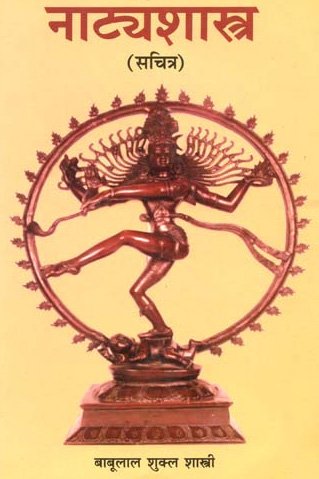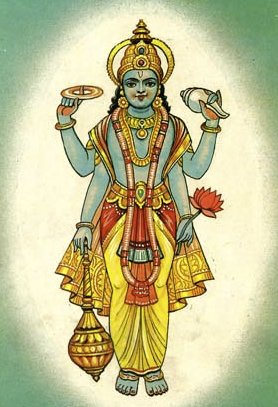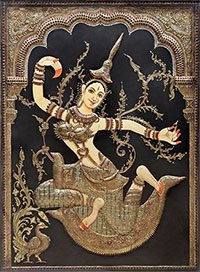Shranta, Śrāntā, Shramta: 17 definitions
Introduction:
Shranta means something in Buddhism, Pali, Hinduism, Sanskrit, Marathi. If you want to know the exact meaning, history, etymology or English translation of this term then check out the descriptions on this page. Add your comment or reference to a book if you want to contribute to this summary article.
The Sanskrit term Śrāntā can be transliterated into English as Sranta or Shranta, using the IAST transliteration scheme (?).
In Hinduism
Natyashastra (theatrics and dramaturgy)
Source: Wisdom Library: Nāṭya-śāstraŚrāntā (श्रान्ता, “tired”) refers to a specific “glance” (dṛṣṭi), according to the Nāṭyaśāstra chapter 8. This is a type of glance that expresses a ‘transitory state’ (saṃcāribhāva). There are a total thirty-six glances defined.
Source: archive.org: Natya ShastraŚrāntā (श्रान्ता).—A type of glance (dṛṣṭi) expressing a transitory state (saṃcāribhāva);—The resting Glance in which eyelids have been let down due to fatigue, corners of the eyes are narrowed, and the eyeballs are fallen, is called Śrāntā (tired).
Uses of Śrāntā (tired)—in weariness and depression.
Source: Shodhganga: Elements of Art and Architecture in the Trtiyakhanda of the Visnudharmottarapurana (natya)Śrāntā (श्रान्ता) refers to one of the Thirty six kinds of Glances (dṛṣṭi) or “proper accomplishment of glances” (in Indian Dramas), according to the Viṣṇudharmottarapurāṇa, an ancient Sanskrit text which (being encyclopedic in nature) deals with a variety of cultural topics such as arts, architecture, music, grammar and astronomy.—Dṛṣṭi is very important in a dance form. The appropriate movements of eyes, eyeballs and eyebrows of an artist make the performance more charming. There are thirty six kinds of glances (dṛṣṭi) accepted in the Viṣṇudharmottarapurāṇa, for example śrāntā, belonging to the sañcāriṇadṛṣṭi division.

Natyashastra (नाट्यशास्त्र, nāṭyaśāstra) refers to both the ancient Indian tradition (shastra) of performing arts, (natya—theatrics, drama, dance, music), as well as the name of a Sanskrit work dealing with these subjects. It also teaches the rules for composing Dramatic plays (nataka), construction and performance of Theater, and Poetic works (kavya).
Vaishnavism (Vaishava dharma)
Source: Brill: Śaivism and the Tantric Traditions (vaishnavism)Śrānta (श्रान्त) refers to a “weary traveler”, according to the Vedānta Deśika’s Yatirājasaptati.—When we come to the poem’s understanding of the divinity of Rāmānuja we find a wide spectrum of meanings. [...] Verse 28 is particularly eloquent in describing and encapsulating all his nurturing and protecting qualities, which are compared to those present everywhere in nature itself—as the mountain from which originate all the streams of knowledge, the tree under which the weary traveler (śrānta) wandering in saṃsāra takes rest, the rising sun that keeps the illusionary darkness of those with distorted views at bay and the full moon that brings to high tide the ocean of the Vedas.

Vaishnava (वैष्णव, vaiṣṇava) or vaishnavism (vaiṣṇavism) represents a tradition of Hinduism worshipping Vishnu as the supreme Lord. Similar to the Shaktism and Shaivism traditions, Vaishnavism also developed as an individual movement, famous for its exposition of the dashavatara (‘ten avatars of Vishnu’).
Purana and Itihasa (epic history)
Source: archive.org: Shiva Purana - English TranslationŚrānta (श्रान्त) refers to “being tired (of seeing one’s own portrayal)”, according to the Śivapurāṇa 2.3.41 (“Description of the Altar-Structure”).—Accordingly, as Brahmā narrated to Nārada: “[...] O great sage, tired (śrānta) of seeing the portrayal of yourself, you became engaged in seeing the other builds of Viśvakarman. You entered the great altar of Himavat, studded with various gems and decorated with gold pots and stumps of plantain trees. It had a thousand columns. It was wonderful. O sage, you were struck with surprise on seeing the altars. [...]”.

The Purana (पुराण, purāṇas) refers to Sanskrit literature preserving ancient India’s vast cultural history, including historical legends, religious ceremonies, various arts and sciences. The eighteen mahapuranas total over 400,000 shlokas (metrical couplets) and date to at least several centuries BCE.
Sports, Arts and Entertainment (wordly enjoyments)
Source: archive.org: Syainika Sastra of Rudradeva with English Translation (art)Śrānta (श्रान्त) refers to “being fatigued” (after hawking), according to the Śyainika-śāstra: a Sanskrit treatise dealing with the divisions and benefits of Hunting and Hawking, written by Rājā Rudradeva (or Candradeva) in possibly the 13th century.—Accordingly, [while discussing the outlines of hawking]: “Thus after hawking the fatigued king (śrānta) should take rest in a shady place, fanned by, soft breezes fragrant a the perfume of lotuses. His followers should then all rally , even those who formed the circle. The chief among them should present to the king all that they have bagged in hawking and speak about the achievements of the hawks, etc., for the amusement, of their lord. [...]”.

This section covers the skills and profiencies of the Kalas (“performing arts”) and Shastras (“sciences”) involving ancient Indian traditions of sports, games, arts, entertainment, love-making and other means of wordly enjoyments. Traditionally these topics were dealt with in Sanskrit treatises explaing the philosophy and the justification of enjoying the pleasures of the senses.
In Buddhism
Tibetan Buddhism (Vajrayana or tantric Buddhism)
Source: academia.edu: The Structure and Meanings of the Heruka MaṇḍalaŚrāntā (श्रान्ता) is the name of a Ḍākinī who, together with the Vīra (hero) named Śrāntacinta forms one of the 36 pairs situated in the Vākcakra, according to the 10th century Ḍākārṇava chapter 15. Accordingly, the vākcakra refers to one of the three divisions of the nirmāṇa-puṭa (emanation layer’), situated in the Herukamaṇḍala. The 36 pairs of Ḍākinīs [viz., Śrāntā] and Vīras are reddish madder in color; they each have one face and four arms; they hold a skull bowl, a skull staff, a small drum, and a knife.

Tibetan Buddhism includes schools such as Nyingma, Kadampa, Kagyu and Gelug. Their primary canon of literature is divided in two broad categories: The Kangyur, which consists of Buddha’s words, and the Tengyur, which includes commentaries from various sources. Esotericism and tantra techniques (vajrayāna) are collected indepently.
Languages of India and abroad
Marathi-English dictionary
Source: DDSA: The Molesworth Marathi and English Dictionaryśrānta (श्रांत).—p (S) Wearied, tired, fatigued, spent.
Source: DDSA: The Aryabhusan school dictionary, Marathi-Englishśrānta (श्रांत).—p Wearied, tired, spent.
Marathi is an Indo-European language having over 70 million native speakers people in (predominantly) Maharashtra India. Marathi, like many other Indo-Aryan languages, evolved from early forms of Prakrit, which itself is a subset of Sanskrit, one of the most ancient languages of the world.
Sanskrit dictionary
Source: DDSA: The practical Sanskrit-English dictionaryŚrānta (श्रान्त).—p. p. [śram-kta]
1) Wearied, tired, fatigued, exhausted; आरभेतैव कर्माणि श्रान्तः श्रान्तः पुनः पुनः (ārabhetaiva karmāṇi śrāntaḥ śrāntaḥ punaḥ punaḥ) Manusmṛti 9.3.
2) Calmed, tranqil.
-taḥ An ascetic.
Source: Cologne Digital Sanskrit Dictionaries: Shabda-Sagara Sanskrit-English DictionaryŚrānta (श्रान्त).—mfn.
(-ntaḥ-ntā-ntaṃ) 1. Wearied, fatigued. 2. Calmed, tranquil. m.
(-ntaḥ) An ascetic, one with subdued passions. E. śram to be weary, aff. kta .
Source: Cologne Digital Sanskrit Dictionaries: Cappeller Sanskrit-English DictionaryŚrānta (श्रान्त).—[adjective] tired, worn out, exhausted; [neuter] weariness, exhaustion, self-castigation, ascetism.
Source: Cologne Digital Sanskrit Dictionaries: Monier-Williams Sanskrit-English Dictionary1) Śrānta (श्रान्त):—[from śram] a mfn. wearied, fatigued, tired, exhausted (-klānta mfn. ‘wearied and exhausted’), pained, distressed, [Ṛg-veda] etc. etc.
2) [v.s. ...] hungry, [cf. Lexicographers, esp. such as amarasiṃha, halāyudha, hemacandra, etc.]
3) [v.s. ...] calmed, tranquil (= śānta), [cf. Lexicographers, esp. such as amarasiṃha, halāyudha, hemacandra, etc.]
4) [v.s. ...] m. Name of a son of Āpa, [Viṣṇu-purāṇa]
5) [v.s. ...] n. fatigue, exertion, self-mortification, religious austerity (or its fruit), [Ṛg-veda; Taittirīya-saṃhitā; Aitareya-brāhmaṇa; Kātyāyana-śrauta-sūtra]
6) b etc. See under √1. śram, p. 1096, col. 2.
Source: Cologne Digital Sanskrit Dictionaries: Yates Sanskrit-English DictionaryŚrānta (श्रान्त):—[(ntaḥ-ntā-ntaṃ)] 1. m. An ascetic. a. Wearied; calm; subdued.
Source: DDSA: Paia-sadda-mahannavo; a comprehensive Prakrit Hindi dictionary (S)Śrānta (श्रान्त) in the Sanskrit language is related to the Prakrit words: Thakkia, Saṃta.
[Sanskrit to German]
Sanskrit, also spelled संस्कृतम् (saṃskṛtam), is an ancient language of India commonly seen as the grandmother of the Indo-European language family (even English!). Closely allied with Prakrit and Pali, Sanskrit is more exhaustive in both grammar and terms and has the most extensive collection of literature in the world, greatly surpassing its sister-languages Greek and Latin.
Kannada-English dictionary
Source: Alar: Kannada-English corpusŚrāṃta (ಶ್ರಾಂತ):—
1) [adjective] fatigued; tired; weary.
2) [adjective] quiet; calm; not perturbed.
3) [adjective] being in a state of rest; quiescent; resting.
--- OR ---
Śrāṃta (ಶ್ರಾಂತ):—
1) [noun] that which is tired.
2) [noun] a tired man.
3) [noun] a man free from disturbance, agitation, anger, etc.; a calm, peaceful man.
4) [noun] a man who has subdued his passions; a sage.
5) [noun] a hungry man.
6) [noun] (dance.) a languid glance which does not go too far, is moved up, then eyelids are let down, expressing tiredness.
Kannada is a Dravidian language (as opposed to the Indo-European language family) mainly spoken in the southwestern region of India.
See also (Relevant definitions)
Starts with: Shrantachinta, Shrantacinta, Shrantacitta, Shrantagata, Shrantahridaya, Shrantaklanta, Shrantamanas, Shrantan, Shrantasad, Shrantasamvahana.
Ends with: Abhasavishranta, Ajishramta, Aparishranta, Ashranta, Avishranta, Kshutpipasaparishranta, Mrigavyashranta, Natishranta, Parishranta, Parivishranta, Pathashramta, Pratinishranta, Pratishranta, Ratishranta, Samparishranta, Samshranta, Suparishranta, Sushranta, Vishranta, Vivekavishranta.
Full-text (+28): Shrantasamvahana, Ashranta, Vishranta, Parishranta, Santa, Shrantamanas, Shrantahridaya, Shrantaklanta, Vishrantavidyadhara, Shrantasad, Vishrantakatha, Vishrantapushpodgama, Shramta, Vishrantavidyavinoda, Shram, Vishrantavaira, Vishrantanyasa, Shrantacitta, Vishrantavilasa, Vishrantakarnayugala.
Relevant text
Search found 18 books and stories containing Shranta, Śrāntā, Shramta, Sranta, Śrānta, Śrāṃta; (plurals include: Shrantas, Śrāntās, Shramtas, Srantas, Śrāntas, Śrāṃtas). You can also click to the full overview containing English textual excerpts. Below are direct links for the most relevant articles:
Rig Veda (translation and commentary) (by H. H. Wilson)
Manusmriti with the Commentary of Medhatithi (by Ganganatha Jha)
Verse 9.300 < [Section XXXIX - The Seven ‘Limbs’ of the Kingdom (saptāṅga)]
Chaitanya Bhagavata (by Bhumipati Dāsa)
Verse 2.24.35 < [Chapter 24 - The Lord Displays His Universal Form to Advaita]
Verse 1.13.111 < [Chapter 13 - Defeating Digvijayī]
Bhakti-rasamrta-sindhu (by Śrīla Rūpa Gosvāmī)
Verse 3.3.18 < [Part 3 - Fraternal Devotion (sakhya-rasa)]
Garga Samhita (English) (by Danavir Goswami)
Verse 2.2.40 < [Chapter 2 - Description of Girirāja Govardhana’s Birth]
Vishnudharmottara Purana (Art and Architecture) (by Bhagyashree Sarma)
2.6. Dṛṣṭi (sight or glance) < [Chapter 3 - Drama and Dance]